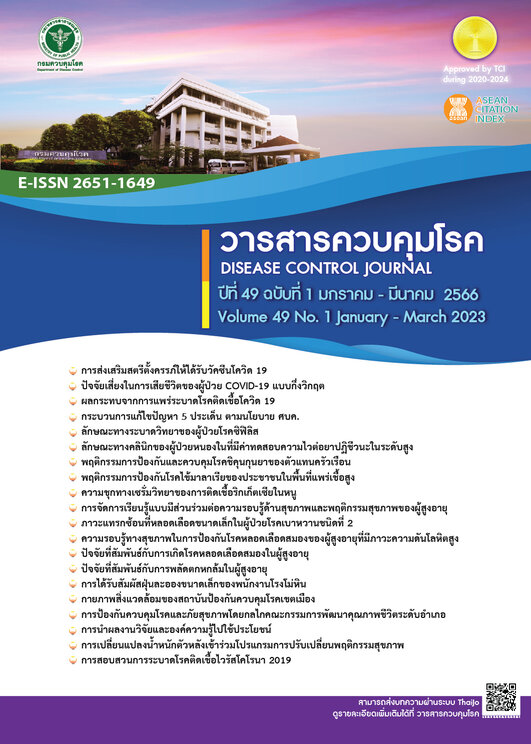A 10-year retrospective study: clinical characteristics of high alert minimal inhibitory concentration in gonorrhea at Bangrak STIs Center
DOI:
https://doi.org/10.14456/dcj.2023.6Keywords:
Gonorrhea, Neisseria gonorhoeae, Antimicrobial resistance N. gonorhoeae monitoringAbstract
Gonorrhea is a sexually transmitted infection that remains a major public health concern in Thailand and globally. Thailand has been facing with the problem of antimicrobial resistance (AMR) in Neisseria gonorrhoeae. From the 10-year antibiotic susceptibility monitoring of Neisseria gonorrhoeae at Bangrak STIs Center, 8 of the 3,660 total cases were reported getting infected with the “watch list” AMR Gonorrhea. It was found that the isolates from the 6 cases had reached alert value of Azithromycin sensitivity test and revealed Azithromycin non-susceptibility. Two isolates reached the alert Cefixime minimal inhibitory concentration (MIC) but only 1 of them was not susceptible to Cefixime. However, there was no gonorrhea case report with Ceftriaxone non-susceptibility. The isolates that demonstrated Azithromycin non-susceptibility were found in genitalia, throat and anus, while 2 isolates that had Cefixime susceptibility test above MIC break point were found only in urethra. In Thailand, the first detected case of antibiotic non-susceptibility of Neisseria gonorrhoeae was reported in 2017 and the trend has been increased. Therefore, the area coverage of AMR surveillance system in Neisseria gonorrhoeae should be expanded in Thailand. Laboratory tests should be required in gonorrhea diagnosis to guide the proper antibiotics use for reducing the problems regarding AMR in the future.
Downloads
References
World Health Organization (WHO). Sexually transmitted infections (STIs) [Internet]. [cited 2022 Mar 22]. Available from: https://www.who.int/news-room/fact-sheets/detail/sexually-transmitted-infections-(stis)
National Disease Surveillance Report 506. Sexually transmitted infections [Internet]. [cited 2022 Jun 19]. Available from: http://doe.moph.go.th/surdata/index.php (in Thai)
Hook EW, Handfield HH. Gonococcal Infections in the Adult. In: Holmes KK, Sparling F, Stamm WE, et al, editors. Sexually Transmitted Diseases. 4th ed. New York: McGraw-Hill; 2008. p. 627–42.
Thavornwattanayong W. Rational Drug Use in Community Pharmacy: RDU Pharmacy [Internet]. [cited 2022 Jun 16]. Available from: http://ndi.fda.moph.go.th/uploads/archives_file/20191011103233.pdf (in Thai)
Sirivongrangson P, Girdthep N, Sukwicha W, Buasakul P, Tongtoyai J, Weston E, et al. The first year of the global enhanced gonococcal antimicrobial surveillance programme (EGASP) in Bangkok, Thailand, 2015-2016. PLoS One. 2018;13(11):2015–6.
Kittiyaowamarn R, Kongtian S, editors. Gonorrhea Treatment Guideline in Thailand 2019. 1st ed. Bangkok: Bangrak STIs Center; 2019. (in thai)
Unemo M, Shafer WM. Antimicrobial resistance in Neisseria gonorrhoeae in the 21st Century: Past, evolution, and future. Clin Microbiol Rev. 2014;27(3):587–613.
World Health Organization (WHO). Gonococcal Antimicrobial Surveillance Programme (GASP) [Internet]. 2022 [cited 2022 Mar 22]. Available from: https://www.who.int/initiatives/gonococcal-antimicrobial-surveillance-programme
Lewis II JS, Weinstein MP, Bobenchik AM, Campeau S, Cullen SK, Galas MF. Zone Diameter and MIC Breakpoints for Neisseria gonorrhoeae. Clin Lab Stand Inst. 2022;1:90–2.
Centers for Disease Control and Prevention. Sexually transmitted diseases (STDs): Life Stages and Populations [Internet]. 2021 [cited 2022 Mar 22]. Available from: https://www.cdc.gov/std/life-stages-populations/adolescents-youngadults.htm
Ison CA, Town K, Obi C, Chisholm S, Hughes G, Livermore DM, et al. Decreased susceptibility to cephalosporins among gonococci: Data from the Gonococcal Resistance to Antimicrobials Surveillance Programme (GRASP) in England and Wales, 2007-2011. Lancet Infect Dis. 2013;13(9):762–8.
Hook EW, Brady WE, Reichart CA, Upchurch DM. Determinants of emergence of antibiotic-resistant Neisseria gonorrhoeae. J Infect Dis. 1989;159(5):900–7.
Trecker MA, Waldner C, Jolly A, Liao M, Gu W, Dillon JAR. Behavioral and socioeconomic risk factors associated with probable resistance to ceftriaxone and resistance to penicillin and tetracycline in Neisseria gonorrhoeae in Shanghai. PLoS One. 2014;9(2):1-9.
Public Health England. Sexually transmitted infections (STIs) [Internet]. 2017 [cited 2022 Mar 22]. Available from: https://www.gov.uk/government/statistics/sexually-transmitted-infections-stis-annual-data-tables
Rashighi M, Harris JE. Neisseria gonorrhoeae Antimicrobial Resistance among Men who Have Sex with Men and Men who Have Sex with Women, the Gonococcal Isolate Surveillance Project, 2005–2010. Physiol Behav. 2017;176(3):139–48.
Cole MJ, Spiteri G, Town K, Unemo M, Hoffmann S, Chisholm SA, et al. Risk factors for antimicrobial-resistant neisseria gonorrhoeae in Europe. Sex Transm Dis. 2014;41(12):723–9.
Wind CM, Schim Van Der Loeff MF, Van Dam AP, De Vries HJ, Van Der Helm JJ. Trends in antimicrobial susceptibility for azithromycin and ceftriaxone in Neisseria gonorrhoeae isolates in amsterdam, the Netherlands, between 2012 and 2015. Eurosurveillance. 2017;22(1).
Town K, Obi C, Quaye N, Chisholm S, Hughes G. Drifting towards ceftriaxone treatment failure in gonorrhoea: risk factor analysis of data from the Gonococcal Resistance to Antimicrobials Surveillance Programme in England and Wales. Sex Transm Infect. 2017;93(1):39–45.
Serra-pladevall J, Caballero E, Roig G, Juvé R, Barbera MJ, Andreu A. Comparison between conventional culture and NAATs for the microbiological diagnosis in gonococcal infection. Diagn Microbiol Infect Dis. 2015;8–10.
Eyre DW, Sanderson ND, Lord E, Regisford-Reimmer N, Chau K, Barker L, et al. Gonorrhoea treatment failure caused by a Neisseria gonorrhoeae strain with combined ceftriaxone and high-level azithromycin resistance, England, February 2018. Eurosurveillance. 2018;23(27):1–6.
Workowski KA, Bolan GA. Sexually Transmitted Diseases Treatment Guideline, 2015. MMWR Recomm Rep. 2015;64(3):1-136.
Workowski KA, Bachmann LH, Chan PA, Johnston CM, Muzny CA, Park I, et al. Sexually transmitted diseases treatment guidelines 2021. MMWR Recomm Rep. 2021;70(4):1-187.
Kongkergkiat N, Kittiyaowaman R, Daengsaard E, editors. Sexually transmitted infections treatment guideline 2015. 2nd ed. Bangkok: Aksorn Graphic and Design; 2015. (in Thai)
Downloads
Published
How to Cite
Issue
Section
License
Copyright (c) 2023 Disease Control Journal

This work is licensed under a Creative Commons Attribution-NonCommercial-NoDerivatives 4.0 International License.
Articles published in the Disease Control Journal are considered as academic work, research or analysis of the personal opinion of the authors, not the opinion of the Thailand Department of Disease Control or editorial team. The authors must be responsible for their articles.






